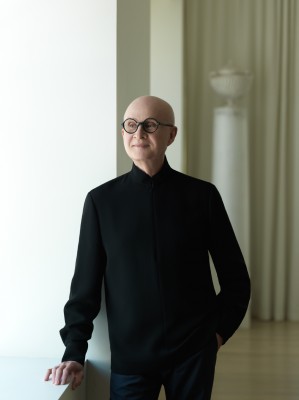
“In 1985 I was a designer at Gensler. I was invited to create a line of furniture for HBF [Hickory Business Furniture]. I could not do it because I was employed by Gensler, and that was a conflict of interest, so we made an agreement that I would create a separate studio with my name two blocks from Gensler. I continued working for Gensler and my studio until the summer of 1987, when I decided that I was going to completely sever the relationship with Gensler and devote my time to my own studio.
I was only going to design furniture and didn’t want to do interior-architecture work, but work came to me, and I was tempted, so I began doing interior work again. Of course, for that I had to hire people: I hired one, I hired two, I hired three, and I reached a point that I had 35 people. That became exhausting so I hired a business consultant to help me reduce the staff from 35 to what I ideally wanted, which was 10 to 12. In business, one problem is not having enough work, another is having too much work. When you have too much work you can’t reduce it in 24 hours. You need time—especially in our business, which involves design and construction—to scale down.
Most people think my success is about beauty and inspiration. No, it’s about being a good businessperson. I’m very pragmatic; dreaming is secondary to me. So I focus on the business first and the design second. Most designers do the opposite, and that’s why they aren’t economically successful. I’m always on top of my sales, fees, contracts, staffing, and benefits. As a result, I have a very high return for the design business, often 20–25 percent, much greater than the 10–12 percent profit on which most design firms operate.
Early on, I made a business decision to avoid specializing in only residential or only commercial work. That has helped us, because the markets for residential and commercial historically have not been correlated, and designers who specialize in one or the other either have a lot of work or no work. We always have something going on.
No one can put a foot ahead of us when it comes to project quality. We’re a small office of around 20 people now, most of whom have been here for years. And we do many deals with design fees that are upwards of $5 million. So if we deliver the quality, have a reliable staff, and win substantial projects, we have the makings of a successful business.
Five-Year Plan
Looking ahead with Orlando Diaz-Azcuy
The future of ODA Design Associates lies in the capable hands of its greatest asset: its small, loyal, and talented team of employees.Within the next few years, Diaz-Azcuy says he plans to:
• Restructure the organization to boost senior management and pass more responsibilities to seasoned employees of the firm
• Transfer full ownership of firm to associates
• Develop a new endeavor in another design-oriented field
I try to teach my staff to be better businesspeople. Most people who come into this profession are concerned about what inspires them and what looks good; they never learned how to get things done and well. For example, a manufacturer we recently hired to produce a material for us became ill, so I told one of my designers to figure out how we were going to get the material. He said he didn’t feel comfortable talking to the manufacturer about that. I said, “That’s part of your job, to confront hard decisions like that because, if the material isn’t delivered, we are going to be responsible.” Most young people aren’t taught that and will only learn it after 10 to 20 years.
This sense of discipline may come from my Cuban background. Americans are constantly telling their children how much they love them and what a great job they did. That’s not part of Hispanic culture, where children are told what to do, then to go and do it. Learning to do things and do them well—for yourself, without expecting praise—has given me the attitude that there has to be discipline in what you do. For example, I’m flexible with my staff if they have problems, but otherwise the work schedule is 8:30 a.m. to 5:30 p.m. You have to be here, and if you leave, you write down where you’re going to be so we know where to find you if a problem arises. That teaches people to follow rules. So if I brought that with me, let it be.”


